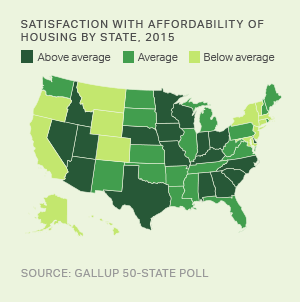Story Highlights
- 49% of renters and 25% of homeowners worry about paying for housing
- More renters than homeowners worry at all income levels
- Gap in owner-renter worry growing for the middle- and upper-income
PRINCETON, N.J. -- Americans who rent their home are nearly twice as likely as those who own their home to say they worry about not being able to pay their housing costs. While upper-income Americans are more likely to own and lower-income Americans are more likely to rent, renters worry more than homeowners at all income levels.
| Renters% | Homeowners% | Difference(pct. pts.) | |||||||||||||||||||||||||||||||||||||||||||||||||||||||||||||||||||||||||||||||||||||||||||||||||
|---|---|---|---|---|---|---|---|---|---|---|---|---|---|---|---|---|---|---|---|---|---|---|---|---|---|---|---|---|---|---|---|---|---|---|---|---|---|---|---|---|---|---|---|---|---|---|---|---|---|---|---|---|---|---|---|---|---|---|---|---|---|---|---|---|---|---|---|---|---|---|---|---|---|---|---|---|---|---|---|---|---|---|---|---|---|---|---|---|---|---|---|---|---|---|---|---|---|---|---|
| National adults | 49 | 25 | 24 | ||||||||||||||||||||||||||||||||||||||||||||||||||||||||||||||||||||||||||||||||||||||||||||||||
| Annual household income | |||||||||||||||||||||||||||||||||||||||||||||||||||||||||||||||||||||||||||||||||||||||||||||||||||
| Less than $30,000 | 63 | 47 | 16 | ||||||||||||||||||||||||||||||||||||||||||||||||||||||||||||||||||||||||||||||||||||||||||||||||
| $30,000 to $74,999 | 42 | 27 | 15 | ||||||||||||||||||||||||||||||||||||||||||||||||||||||||||||||||||||||||||||||||||||||||||||||||
| $75,000 or more | 29 | 15 | 14 | ||||||||||||||||||||||||||||||||||||||||||||||||||||||||||||||||||||||||||||||||||||||||||||||||
| 2013-2016 Gallup Economy and Personal Finance Surveys | |||||||||||||||||||||||||||||||||||||||||||||||||||||||||||||||||||||||||||||||||||||||||||||||||||
These results are based on more than 5,000 combined interviews from Gallup's 2013-2016 Economy and Personal Finance surveys, including 3,606 homeowners and 1,294 renters.
Overall, during this time, 33% of Americans said they were very (15%) or moderately (18%) worried about not being able to pay their "rent, mortgage or other housing costs."
As would be expected, lower-income Americans are more likely than upper-income Americans to worry about meeting their housing costs, and income is a stronger predictor of worry than homeownership status. For example, lower-income homeowners (47%) are more likely to worry about not being able to pay their housing obligations than are middle- or upper-income renters (42% and 29%, respectively). But at every income level, there is a roughly 15-percentage-point gap in worry between homeowners and renters.
Homeowners, regardless of income, may worry less than renters because they likely have more stable housing payments. Their principal and interest payments on a mortgage would be fixed in most cases, with only minor year-to-year increases in property taxes and insurance. Renters, on the other hand, probably could expect more significant year-to-year rent increases.
Also, rental payments for a given renter would mostly reflect current real estate market conditions, whereas mortgage payments for a given homeowner would mostly reflect home values at the time the home was purchased, which could be well below current home values in the area.
Finally, other financial considerations beyond household income may lead people to rent rather than own a home and to be more worried about their finances in general. These could include concerns about job security, high levels of personal debt or insufficient savings to come up with a down payment on a house.
Worry Gap for Middle- and Upper-Income Americans Widens
Gallup has consistently found that renters are more worried than homeowners about making housing payments, both overall and by household income level, in the 16 years it has conducted the Economy and Personal Finance survey. But the gap in homeowner-renter worry has increased among both middle- and upper-income owners compared with the past.
Homeowners and renters at all income levels became increasingly worried about paying housing costs from 2008 through 2012, during the recession and immediate post-recession years, compared with the 2001 through 2007 housing boom. In recent years, middle- and upper-income homeowners' worry has eased. But middle-income renters are only slightly less worried, and upper-income renters have become more likely to worry.
| Renters% | Homeowners% | Difference(pct. pts.) | |||||||||||||||||||||||||||||||||||||||||||||||||||||||||||||||||||||||||||||||||||||||||||||||||
|---|---|---|---|---|---|---|---|---|---|---|---|---|---|---|---|---|---|---|---|---|---|---|---|---|---|---|---|---|---|---|---|---|---|---|---|---|---|---|---|---|---|---|---|---|---|---|---|---|---|---|---|---|---|---|---|---|---|---|---|---|---|---|---|---|---|---|---|---|---|---|---|---|---|---|---|---|---|---|---|---|---|---|---|---|---|---|---|---|---|---|---|---|---|---|---|---|---|---|---|
| Less than $30,000 | |||||||||||||||||||||||||||||||||||||||||||||||||||||||||||||||||||||||||||||||||||||||||||||||||||
| 2001-2007 | 47 | 32 | 15 | ||||||||||||||||||||||||||||||||||||||||||||||||||||||||||||||||||||||||||||||||||||||||||||||||
| 2008-2012 | 66 | 48 | 18 | ||||||||||||||||||||||||||||||||||||||||||||||||||||||||||||||||||||||||||||||||||||||||||||||||
| 2013-2016 | 63 | 47 | 16 | ||||||||||||||||||||||||||||||||||||||||||||||||||||||||||||||||||||||||||||||||||||||||||||||||
| $30,000 to $74,999 | |||||||||||||||||||||||||||||||||||||||||||||||||||||||||||||||||||||||||||||||||||||||||||||||||||
| 2001-2007 | 32 | 23 | 9 | ||||||||||||||||||||||||||||||||||||||||||||||||||||||||||||||||||||||||||||||||||||||||||||||||
| 2008-2012 | 45 | 33 | 12 | ||||||||||||||||||||||||||||||||||||||||||||||||||||||||||||||||||||||||||||||||||||||||||||||||
| 2013-2016 | 42 | 27 | 15 | ||||||||||||||||||||||||||||||||||||||||||||||||||||||||||||||||||||||||||||||||||||||||||||||||
| $75,000 or more | |||||||||||||||||||||||||||||||||||||||||||||||||||||||||||||||||||||||||||||||||||||||||||||||||||
| 2001-2007 | 16 | 11 | 5 | ||||||||||||||||||||||||||||||||||||||||||||||||||||||||||||||||||||||||||||||||||||||||||||||||
| 2008-2012 | 25 | 20 | 5 | ||||||||||||||||||||||||||||||||||||||||||||||||||||||||||||||||||||||||||||||||||||||||||||||||
| 2013-2016 | 29 | 15 | 14 | ||||||||||||||||||||||||||||||||||||||||||||||||||||||||||||||||||||||||||||||||||||||||||||||||
| Gallup | |||||||||||||||||||||||||||||||||||||||||||||||||||||||||||||||||||||||||||||||||||||||||||||||||||
Those trends likely follow rent costs, which have consistently increased in recent years, particularly in higher-priced markets. There are some indications these gains may be leveling off as rental supply is now catching up to, or exceeding, rental demand.
Implications
The bursting of the housing bubble helped push the economy into recession and drove Americans' homeownership rate down to 62% from 73% in 2005-2007, according to Gallup's data. That decline is a result of multiple factors, including many former homeowners losing their homes to foreclosure and tighter lending requirements for getting new mortgages. Also, potential home buyers may not be as confident that homes will hold their value after seeing prices plummet in recent years. Finally, many within the growing retiree population may be choosing to sell their homes and rent, while young adults living on their own for the first time may look to live in cities or other areas where renting is more feasible than owning.
The declining percentage of homeowners and the increasing percentage of renters in the U.S. adult population help explain why Americans today are significantly more worried about being able to pay their housing costs than they were in the past. From 2001 through 2007, before the housing market crashed, an average 24% of Americans worried about paying their housing costs. Since then, an average of 35% have. Although Americans' worry about a variety of financial matters is up since 2007, worries about making housing payments are up the most.
In an era when most Americans are seeing slow wage growth, more are renting than in the past and rental costs have been rising significantly, it is understandable that an increasing percentage of Americans are worried about meeting one of their most basic financial obligations.
Historical data are available in Gallup Analytics.
Survey Methods
Results for this Gallup poll are based on combined telephone interviews conducted from Gallup's April 2013 to 2016 Economy and Personal Finance surveys, with a random sample of 5,073 adults, aged 18 and older, living in all 50 U.S. states and the District of Columbia. For results based on the total sample of national adults, the margin of sampling error is ±2 percentage points at the 95% confidence level.
For results based on the total sample of 3,606 homeowners, the margin of sampling error is ±2 percentage points at the 95% confidence level.
For results based on the total sample of 1,294 renters, the margin of sampling error is ±3 percentage points at the 95% confidence level.
All reported margins of sampling error include computed design effects for weighting.
Each sample of national adults includes a minimum quota of 60% cellphone respondents and 40% landline respondents, with additional minimum quotas by time zone within region. Landline and cellular telephone numbers are selected using random-digit-dial methods.
Learn more about how the Gallup Poll Social Series works.




